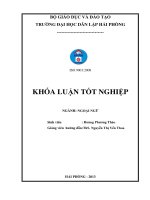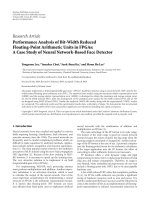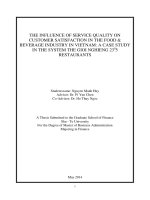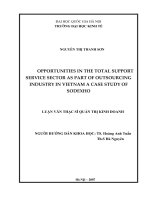Develop car loan at Toyota dealers in Vietnam a case study of TFSVN
Bạn đang xem bản rút gọn của tài liệu. Xem và tải ngay bản đầy đủ của tài liệu tại đây (521.98 KB, 107 trang )
MINISTRY OF EDUCATION AND TRAINING
UNIVERSITY OF ECONOMICS HO CHI MINH CITY
NGUYEÃN HOAØNG DUY
DEVELOP CAR LOAN AT TOYOTA
DEALERS IN VIETNAM
A CASE STUDY OF TFSVN
MASTER’S THESIS
HO CHI MINH CITY – 2010
MINISTRY OF EDUCATION AND TRAINING
UNIVERSITY OF ECONOMICS HO CHI MINH CITY
NGUYEN HOAỉNG DUY
DEVELOP CAR LOAN AT TOYOTA
DEALERS IN VIETNAM
A CASE STUDY OF TFSVN
MAJOR : BANKING
MAJOR CODE : 60.31.12
MASTERS THESIS
THESIS INSTRUCTOR: DR. A. PR. PHAẽM VAấN NAấNG
HO CHI MINH CITY 2010
i
ACKNOWLEDGEMENTS
This paper could not have been completed without the help, encouragement and
support from a number of people who all deserve my sincerest gratitude and appreciation.
First of all, I would like to express my special thanks to Dr. A. Pr. Phaùm Vaờn Naờng,
my thesis instructor. Im indebted to his inspiration, scholarly supervision and intellectual
support throughout the course of writing this graduation paper. His continual
encouragement, careful reading, critical comments and patient guidance made my work
more enjoyable and easier.
I would like to thank all my beloved teachers at University of Economics Ho Chi Minh
City (UEH), the Post-graduate Faculty for their support and valuable knowledge and
experiences during my study at UEH.
Special words of thank also go to all my colleagues at Toyota Financial Services
Vietnam, Toyota Motor Vietnam, Toyota Authorised Dealers and other interviewees for
their willing participation and ideas in the study. I greatly appreciate their generosity with
their time and efforts in helping me. Without them this paper could not have been possible.
Finally, my deepest gratitude and appreciation go to my family, my friends and my
classmates. Their love, support and constant encouragement gave me a great deal of
strength and determination that help me during the time of writing this paper.
Nguyeón Hoaứng Duy
ii
DECLARATION OF THESIS
Author’s full name : Nguyeãn Hoaøng Duy
Date of birth : 11
th
January 1982
Thesis title : Develop Car Loan at Toyota Dealers – A Case Study of
TFSVN
Thesis instructor : Dr. A. Pr. Phm Vn Nng
Major code : 60.31.12
In order to complete this dissertation, the author spent time on studying,
collecting relevant information, exchanging ideas with experts, working for and
accumulating practical facts from the company’s operation and business. I hereby
declare that the submitted work has been done by me, data and findings given in this
thesis is true and correct. I agree to any crosscheck about the mentioned information
and the dissertation.
Nguyeãn Hoaøng Duy
iii
TABLE OF CONTENT
INTRODUCTION
CHAPTER 1: OVERVIEW OF CAR LOAN 1
1.1 Consumer loan 1
1.1.1 Consumer loan 1
1.1.2 Personal loan 1
1.2 Car loan 1
1.2.1 Car loan 1
1.2.2 Car loan of Banks 2
1.2.3 Common car loan attributes 2
1.3 CAMPARI Model – The Risk management model of Car loan 5
1.4 Credit risk 7
1.5 Overdue debt 8
CHAPTER 2: CAR LOAN AT TOYOTA DEALERS & TFSVN 10
2.1 Overview of Vietnam’s economy in recent years 10
2.1.1 The economic growth 10
2.1.2 GDP per capita 11
2.1.3 Stabilizing the Macro-economy 11
2.2 Overview of Credit institutions in Vietnam 14
2.2.1 Overview of the forms of credit institutions 14
2.2.2 Reform of Vietnam’s banking system 15
2.2.2.1 Overview 15
2.2.2.2 Prospects 16
2.2.2.3 Needs for and potentials of consumer finance 17
2.3 Vietnam automotive industry 18
2.3.1 Development of automotive industry 18
2.3.2 Vietnam’s master plan of the automotive industry 19
iv
2.3.3 Finance and supporting policies 21
2.3.4 The automobile markets in East Asian countries and Vietnam 21
2.4 Toyota Motor Vietnam 23
2.4.1 Introduction 23
2.4.2 Toyota dealer network 24
2.5 Automotive market & Toyota sales in Vietnam 26
2.5.1 Car model purchase in 2009 26
2.5.2 Toyota sales in the world 28
2.5.3 Toyota sales in Vietnam 30
2.5.3.1 Toyota market share in Vietnam 30
2.5.3.2 Toyota sales from Jan to Jun 2010 33
2.5.4 Toyota customer profile 34
2.6 Toyota Financial Services Vietnam (TFSVN) 35
2.6.1 Information on TFSVN 35
2.6.1.1 Incorporation of TFSVN 35
2.6.1.2 Organizational structure 36
2.6.1.3 Legal status 36
2.6.1.4 Legal framework 37
2.6.1.5 Objectives and Scope of business 38
2.6.1.6 TFSVN’s car loan products 39
2.6.1.7 TFSVN’s SWOTs 41
2.6.1.8 Car loan comparison among Banks and TFSVN 41
2.6.2 Car loan at Toyota dealers 44
2.6.2.1 Growing proportion of car loan in Toyota sales 44
2.6.2.2 Car loan sales 46
2.6.2.3 Car loan to individual 48
2.6.2.4 Individual car loan by Bank types and TFSVN 49
2.6.3 TFSVN’s prudential ratios 53
2.6.3.1 Capital Adequacy Ratio 53
v
2.6.3.2 Credit limit to customers 53
2.6.3.3 Payment ability 54
2.6.3.4 Short-term capital for medium to long term lending 55
2.6.4 Loan classification and Provision 55
CHAPTER 3: RECOMMENDATIONS FOR TFSVN 57
3.1 TFSVN’s Credit risk management 57
3.1.1 TFSVN’s Credit risk management principles 57
3.1.2 TFSVN’s Credit risk management process 57
3.1.3 Credit assessment 58
3.2 The orientation of development 63
3.2.1 Niche strategy 63
3.2.1.1 Sales performance 63
3.2.1.2 Customer retention 64
3.2.1.3 Dealer support 64
3.2.2 New products launch 65
3.2.2.1 Car loan to fleet customers 65
3.2.2.2 Car loan for used cars 66
3.2.2.3 Agency for insurance 67
3.2.3 Implement low cost business model 68
3.2.4 Efforts for sustainable growth 68
3.2.5 Short term and Mid-long term plan 70
CONCLUSION 72
LIST OF REFERENCES 73
LIST OF INTERVIEWEES 75
LIST OF APPENDICES 76
APPENDIX 1 77
TOYOTA FINANCE GROUP’S EXPERIENCES IN CONSUMER FINANCE
vi
APPENDIX 2 82
TOYOTA MOTOR VIETNAM
APPENDIX 3 89
ECONOMIC ITEMS
vii
ABBREVIATIONS
BTC : Banking Training and Consultancy
CBU : Complete Built Unit
CKD : Complete Knock Down
CIC : Credit Information Center
CRM : Credit Risk Management
CPI : Consumer Price Index
FDI : Foreign Direct Investment
FED : Federal Reserve System
FDIC : Federal Deposit Insurance Corporation
GDP : Gross Domestic Product
MOF : Ministry of Finance
MNCs : Multi-National Corporations
MPV : Multi-Purposed Vehicle
PC : Passenger Car
SOEs : State-Owned Enterprises
SOCBs : State-Owned Commercial Banks
SBV : State Bank of Vietnam
SFCs : Subsidiary Finance Companies
SUV : Sport Utility Vehicle
TASS : Toyota Authorised Service Station
TFSVN : Toyota Financial Services Vietnam
TFSC : Toyota Financial Services Corporation
TFC : Toyota Finance Corporation
TMC : Toyota Motor Corporation
TMV : Toyota Motor Vietnam
VAMA : Vietnam Automobile Manufacturers’ Association
viii
LIST OF TABLES
Table 2.1: The structure of Vietnam’s economy 10
Table 2.2: List of 17 members of VAMA 19
Table 2.3: Forecasts of automotive output up to 2020 and Existing and required production
capacity up to 2010 20
Table 2.4: Dealers scale 25
Table 2.5: Car model purchase in 2009 26
Table 2.6: Toyota production by region 29
Table 2.7: Toyota sales by region 29
Table 2.8: Estimation of automotive market, Toyota sales and Toyota market share 30
Table 2.9: Market share of VAMA members in 2008 and 2009 31
Table 2.10: Toyota customer profile (Percentage) 34
Table 2.11: An interest rate comparison among Banks and TFSVN 42
Table 2.12: A car loan comparison among typical Commercial local bank (Techcombank),
Foreign bank (HSBC) and the Financial company (TFSVN) 42
Table 2.13: Financed portion and Collateral of car loan 44
Table 2.14: Toyota sales and car loan 45
Table 2.15: Car loan at Toyota dealers 46
Table 2.16: Ratio of customer profile 47
Table 2.17: Car loan to individual 48
Table 2.18: Individual Car loan by bank types and TFSVN 49
Table 2.19: Market share of individual car loan by bank type and TFSVN 51
Table 2.20: Loan classification and Provision 55
Table 3.1: Estimated living expense 60
ix
LIST OF FIGURES
Figure 1.1: Car loan process 4
Figure 1.2: Types of credit risks and affect 7
Figure 1.3: Days of overdue and ratio of return 9
Figure 2.1: Vietnam’s GDP per capita 11
Figure 2.2: Export-Import Growth Rate (%) 13
Figure 2.3: The system of credit institutions in Vietnam 14
Figure 2.4: Automobile market size in Asian countries in 2009 22
Figure 2.5: Establishing Solid Foundation 24
Figure 2.6: Vietnam market segment movement in FDI automakers 2007-2009 27
Figure 2.7: Circle of Vietnam automotive industry 28
Figure 2.8: Toyota market share during 2000-2009 31
Figure 2.9: Market share of VAMA members 32
Figure 2.10: Toyota sales from Jan to Jun 2010 33
Figure 2.11: Customer profile 35
Figure 2.13: TFSVN’s lending process 40
Figure 2.14: Individual car individual loan by bank type and TFSVN 50
Figure 2.15: Market share of individual car loan by bank type and TFSVN 52
Page x
Introduction
INTRODUCTION
1. Rationale of the study
In recent years, the world and Vietnam economy faced so many difficulties due to the
financial crisis and the threat of economic recession. Economical difficulties have posed
tremendous effects on the world and domestic automotive industry, globally vehicle sales
were much lower than previous years, and some big car makers announced loss and are at the
verge of bankruptcy. However, rescue plans and economic packages of many countries and
Vietnam have brought optimistic signs for the economy and people’ lives. We have the right
to believe in that the crisis or difficulties would end soon and people’ lives are better.
With statistics of past years, financial service sector has been improving and Toyota
financed cars has been increasing in Vietnam by years. Toyota Financial Services Vietnam
(TFSVN) was established in the context of not only difficulties but also opportunities.
TFSVN’s financial products and services are designed for Toyota and for Vietnam market.
Those are innovative, which were developed from global experiences of Toyota Financial
Services Corporation (TFSC), and consider Vietnam’s practical elements. The establishment
of TFSVN is to support Toyota, increasing its market share in Vietnam, to bring car buyers
another opportunity to own their desired cars. All is for Vietnamese prosperous lives and the
success of Toyota authorized dealers.
As credit institutions, TFSVN care profit and consider it a motivation for a better
performance generally. Credit is one of key business activities, which bring main income or
profit to the company. However, this kind of activity is the most risky with bad consequences
such as increasing costs, low revenue or loss, bad financial capacity and finally damage the
company image and reputation, even bankruptcy. Credit risks always accompany with credit
activities and cannot be eliminated completely, but only prevented or minimized by efficient
risk management policy.
Page xi
Introduction
At TFSVN, the setting up and implementing credit risk management policy is a
necessity, together with possible strategies, in order to improve the competitiveness. That’s
why I chose the topic “Develop car loan at Toyota dealers in Vietnam – A case study of
TFSVN”
2. Definition of the problem
Consumer lending, car loan attributes
Credit risk elements, types of risk
Result analysis: Vietnam automotive industry, Vietnam automotive market, Toyota
Motor Vietnam, The situation of car loan at Toyota dealers
Toyota Financial Services Vietnam. An analysis of the company, in order to improve
the company’s competitiveness and minimize risk
3. Research questions & objectives
The objective of the thesis is to understand the issues of TFSVN and then we can find out
strategic solutions to improve competitiveness and credit risk management.
Research objectives:
Study on risks and risk management in providing credit services to Toyota car
buyers.
Possible strategies of credit services and products.
To increase Toyota sales volume and its market share.
To increase the company’s profit and market share.
Research questions:
How is the market?
What are advantages and disadvantages, Strength-Weakness-Opportunity-Threat
of the company?
What is efficient credit risk management?
Page xii
Introduction
What is the orientation of development?
4. The object, scope and methodology of the study
Object of the study:
Toyota, Automotive industry and market
The situation of car loan at Toyota dealers in Vietnam.
Toyota Financial Services Vietnam.
Scope of the study: activities of Toyota, Toyota dealers and TFSVN in the period from
2005 to 2009.
Methodology of the study: statistics – analysis – summarization.
The primary data was collected and generated by the author, the research relied on the
data from TMV, TFSVN, Toyota authorized dealers, VAMA, the master plan of Vietnam
automotive industry and companies. Moreover, the secondary data was from policies and
decisions of government, relevant ministries, newspaper, former researches, etc. The
author also exchanged ideas with experts in finance and automotive industry about car
market, car loan, credit risk management and the market trend.
5. Significance of the study
Toyota is the first car maker in Vietnam which launched financed car services of its
own. TFSVN is the 33
rd
financial company of TFSC in the world. The pioneer position gives
Toyota and TFSVN not only opportunities to develop but also difficulties and challenges. The
success of TFSVN is the motivation which local and foreign banks in Vietnam compete with
and other car makers shall plan to establish their financial company of their own. In the
coming time, in addition to individual loan, the company expands to corporate loan. Those
experiences and success will open a way to the future ahead.
6. Structure of the study
Page xiii
Introduction
Introduction of the study
Introduction is about the research, including background, the problems to be solved, research
rationale, introducing its scope, methodology, and the significance of the study.
Chapter 1: Overview of car loan
The chapter is a review of some theories and definitions which are applied and referred for
analysis throughout the paper: consumer loan, car loan, the risk management model of car
loan, credit risk, overdue debt. Especially the car loan CAMPARI model shall be figured out
as an efficient management way to manage risk and support a better sales performance of the
financial company.
Chapter 2: Car loan at Toyota dealers & TFSVN
The overview of Vietnam economy, some relevant issues of the economy; introducing a
general picture of background for the company’s business, in particular the banking sector and
needs for potentials of consumer finance.
The analysis in the chapter: Vietnam automotive industry and market, Toyota, the situation of
car loan at Toyota dealers and TFSVN’s establishment and its sales performance. To highlight
the situation and the background where TFSVN was established and came into operation. The
purpose of analysis is to define problems and opportunities TFSVN have and what to do to in
the future. This chapter concentrated on sales performance, a comparison among TFSVN and
other banks. This would bring the reader a clear picture of the car loan market at Toyota
dealers, and so that we can find out solutions to success for TFSVN in the next chapter.
Chapter 3: Recommendations for TFSVN
In this chapter, we work out the credit risk management and the orientation of development
for TFSVN. And then a conclusion on all what we have discussed and a possibility for any
further research on thesis topic.
Page 1
Chapter 1: Overview of Car loan
CHAPTER 1: OVERVIEW OF CAR LOAN
1.1 Consumer loan
1.1.1 Consumer loan
The division of retail banking that deals with lending money to consumers. This includes a
wide variety of loans, including credit cards, mortgage loans, and auto loans, and can also be
used to refer to loans taken out at either the prime rate or the sub prime rate.
1.1.2 Personal loan
Money loaned to individuals (usually on non-secured basis) for personal, family or
household purposes; as opposed to business or commercial lending. It’s also called consumer
credit or consumer lending.
A personal loan is an unsecured loan, meaning the borrower does not put up any collateral
or security to guarantee the repayment of the loan. For this reason, personal loans tend to
carry high interest rates. If a borrower owns a home, a lower interest rate alternative is a
home equity loan. However, this option requires that the borrower put up his or her home or
other real estate property as collateral.
A loan, whether a personal loan or another type of loan, is typically used to finance a
large, one-time purchase or expense. The borrower is given all the money at once and agrees
to pay back a certain amount per month until the debt is repaid. The monthly payment
includes both principal (the amount you borrowed) and interest.
Personal loans tend to carry higher interest rates than loans secured by collateral such as a
home. The relatively high interest rate compensates for the fact that you aren’t guaranteeing
repayment of the personal loan with some kind of asset.
1.2 Car loan
1.2.1 Car loan
Page 2
Chapter 1: Overview of Car loan
To purchase an automobile that will be driven predominantly for personal or business.
Financed amount will include vehicle price and insurance if allowed by regulations. The
finance vehicle is a secured property.
1.2.2 Car loan of Banks
The local and foreign banks have actively expanded their credit activities, among that
especially car loan in both individual and corporate. This is one of the main banking activities
that bring a significant profit to the banks. In addition, the banks promote car loan program in
order to meet the increasing need of car buyers that makes the car loan market more exciting.
The banks have launched car loan program since 2001. They cooperated with car makers
in giving consultancy to customers about the car model and loans that met customer’s need
and budget. And the banks provide car buyer financial services, with reasonable interest rate,
long term, high financed portion, etc.
After nearly 10 years of implementation, revenue from car loan holds a significant part of
the bank’s total profit. The banks actively work with auto manufacturers to launch promotion,
preferential interest rate or promotional gifts to customers. This partnership is to promote car
sales and expanding the banks’ customer database.
For example, from 15-Mar to 30-Apr-2010, Techcombank in cooperation with Mercedes-
Benz Vietnam conducted a promotional campaign. Among that, the bank shall provide
Mercedes-Benz car buyers a preferential interest rate for the first 12 months of the loan term,
7.99%/year for sedan or under 7-seat vehicles and 11.9%/year for Sprinter (16-seat vehicle).
Besides brand-new car loan, several banks financed used car after the government
allowed used car importation. This service has been very potential and expected to develop
strongly in the future. Brand-new, used car importation and car price decrease have made the
automotive market more exciting and lead to stronger car consumption.
1.2.3 Common car loan attributes
Page 3
Chapter 1: Overview of Car loan
Product benefits
- Financing customers to purchase and own their favorite car. Car Loan provides
customers with the financing package to drive the car they've always dreamt of.
- Documentation, car register are in customer’s name.
- Fast and easy arrangement of loans, simple application and quick credit process.
- Monthly or periodical repayment to the banks or the financial companies.
Application criteria
Individual: Vietnamese, or foreigner residents, or overseas Vietnamese: age from
18 to 65, monthly income can cover the monthly repayment
Business enterprise: operating business at least 2 years
Product attributes
Currency: VND
Loan term: max 4 or 5 years
Financed portion: usually 70% of car price at common, max possibly to 100% of
car price, that depends on borrower’s demand, financial capacity and loan term
Secured asset: the financed car or real estate
Repayment mode: interest calculation on declining balance
Periodical repayment: monthly interest and principal
Fee and charge: according to SBV and the bank’s current regulations
Document required for application
Individuals
Identification card
Household registration book/ Temporary residence book
Marital Status Certificate
Car purchase contract
Proof of income
Copy of other asset ownership certificates (if any)
Page 4
Chapter 1: Overview of Car loan
TFSVN/
Bank
Dealer Customer
Disbursement
Monthly repayment
Loan
Car delivery
Business enterprise
Business license
Company charter
Board of Resolution
Identification card and household registration book of Committees
VAT report of the last 6 months
Tax report of the most recent year
Car purchase contract
Bank statement of the last 6 months (if any)
The loan procedure
The car dealer signed purchase contract with car buyers and transfer the contract
and customer information to the bank
The bank collected documents, investigating and making credit decision
Customers made down payment to the car dealer and the car dealer commence the
process of car registration
The car dealer sent receipt of car register to the bank for disbursement
After disbursement, the bank collected original documents and worked with
customer for monthly repayment
Figure 1.1: Car loan process
Source: author’s collection
Page 5
Chapter 1: Overview of Car loan
1.3 CAMPARI Model – The Risk management model of Car loan
CAMPARI stands for Character – Ability – Means – Purpose – Amount – Repayment -
Insurance
Character
Basic characteristics of customers who are honest, determined, transparent in loan
payment. Manner of payment on previous and existing obligations is important because it is a
very strong indication not only of ability to pay but also of responsibility. Applicants with
records of collection cases, repossessions, bankruptcy, swindling, bounced checks or even
serious personal problems are normally rejected.
Resume of borrower: name, age, education, family, former profile
Payment history
Stability of residence
Life style
The honesty in making the application and providing information
Access Credit Information Centre (CIC)
Reputation in the industry, in the working field
Fame of the company where customers work for
Ability
Evaluating customer’s ability in business organization, finance management and other
specialist skills such as marketing, sales, finance in order to run and manage their business
Finance management
Business organization and management
Sales & Marketing skills
Means
Page 6
Chapter 1: Overview of Car loan
Acknowledging borrower’s income, the source of payment. With this understanding, the
banks or financial companies can evaluate customer’s financial capacity and the loan
settlement.
Properties, real estate, assets
Debt
Investment/Lending
Net value
Purpose
Understanding the real purpose of the car loan and whether customer uses the car as that
purpose. With the acknowledgement of the loan purpose, the lender can settle a suitable
payment plan for the loan.
Purpose
Reason of car purchase
Amount
Evaluating if the car and loan amount suit borrower’s purpose and financial capacity
Loan amount
Monthly payment
Income
Repayment
Understanding borrower’s repayment ability by analyzing the source of repayment,
customer’s willing to make payment, credit history
Income and expense
Repayment ability
Surplus
Insurance
Secured asset is the financed car
Page 7
Chapter 1: Overview of Car loan
Secured asset is just the back-up for the repayment
Secured asset is to ensure that borrower conduct his/her commitment to
payment obligations
Secured asset is insured with TFSVN as the beneficiary during the loan term
1.4 Credit risk
Credit risk is the risk of financial loss occurring as a result of default by a borrower or
counterparty on their obligation to the Bank. Risk is potential unexpected problems which
bring physical damage to the banks and financial institutions, causing profit decline or loss.
Then the banks and financial institutions have to spend an additional amount to fulfill a
financial affair.
Figure 1.2: Types of credit risks and affect
Source: Banking Training & Consultancy (2009), Training course of banking risks
Risk of capital stagnancy
Affecting customers’ capital usage
Obstructing and making difficulties for
payment to depositor
Risk of capital loss
Cost increase
Overdue debt and bad debt
Monitoring expense
Legal expense
Profit decline
Principal loss
Provision implementation
Page 8
Chapter 1: Overview of Car loan
According to item 1 article 2 on loan classification, making provision and using provision
to settle credit risk in banking activities of financial institutions of the Decision 493/2005/Q-
NHNN dated 22
nd
April 2005 issued by the governor of State Bank of Vietnam (SBV). Credit
risk is the possibility of losses in the banking activities because customers or borrowers do not
make or are not able to perform their obligations under commitment.
Credit risk happens when a borrower makes a default in settling debt obligations
under the contract, including principal or/and interest. The default might be a
delayed payment or non-payment.
Credit risk causes financial losses, lowering net income and reducing market value
of principal. In severe cases, it can lead to big losses, or even bankruptcy.
In developing countries like Vietnam, the banks is short of a diversity of personal
financial services, products are still poor, credit is considered as a main income
source and even a unique source, especially for small banks. Therefore, credit risk is
likely high or low which determine the business efficiency of the bank.
Otherwise, risk and profit expectations of the banks are involved each other, higher
risk higher return. Risk is an objective factor that we cannot eliminate it completely,
but only minimize its happening and damage.
1.5 Overdue debt
Ratio of overdue debt =
Ratio of overdue debt customers =
Overdue debt is the most important measure to evaluate the bank’s health and efficiency. It
affects all major business fields of the banks.
Loan classification
The following categories apply, as per Decision 493/2005/QD-NHNN and its amendments:
Balance of overdue debt
Total balance
Overdue debt customers
All customers
Page 9
Chapter 1: Overview of Car loan
Group 1 – Current Loans: loans which are following payback schedule and overdue
less than 10 days.
Group 2 – Special mention loans (delay): loans overdue from 10 to 90 days.
Group 3 – Sub-standard loans (delinquent): loans overdue from 91 to 180 days.
Group 4 – Doubtful loans (legal): loans overdue from 181 to 360 days.
Group 5 – Loss loans (write-offs): loans overdue more than 360 days.
Figure 1.3: Days of overdue and ratio of return
Source: Banking Training & Consultancy (2009), Training course of banking risks
365
days
240 days
120 days
90 days
60 days
30 days
89%
10%
50%
70%
80%
95%
0 50 100 150 200 250 300 350 400
Days of overdue Ratio of return
Page 10
Chapter 2: Car loan at Toyota Dealers & TFSVN
CHAPTER 2: CAR LOAN AT TOYOTA DEALERS & TFSVN
2.1 Overview of Vietnam’s economy in recent years
2.1.1 The economic growth
Vietnam was successfully preventing an economic decline, maintaining a sensible and
sustainable economic growth. Vietnam's economy remains strong, with real GDP growth
estimated to have reached nearly 8.48% in 2007, 6.23% in 2008 and 5.32% in 2009. Following
the impetus of economic recession in months of 2008 year-end, for the whole year of 2009,
GDP increased by 5.32%, of which the agriculture, forestry and fishery sector rose by 1.83%;
the industry and construction by 5.52%; and the services by 6.63%.
Table 2.1: The structure of Vietnam’s economy
Item 2001-2005 2006 2007 2008 2009
Real GDP growth 7.5 8.2 8.48 6.23 5.32
(% of GDP)
Agriculture 20.9 20.4 21 21.99 15.85
Industry 41.0 41.5 42 39.91 41.00
Services 38.1 38.1 37 38.1 43.15
(Average annual growth) %
Agriculture 3.8 3.4 3.41 3.79 1.83
Industry 10.2 10.4 10.6 6.33 5.52
Services 7.0 8.3 8.68 7.2 6.63
Source: Vietnam General Statistics Office (2009)
GDP growth rate in 2009 has reached 5.32%, exceeding the adjusted target 5.2%, the highest
in South East Asia. Vietnam was in 10 countries with positive growth in the world.
Positive growth was in 3 sectors of Agriculture, Industry and Services.
- Agriculture sector was up 1.83%, agriculture at 1.32%, forestry at 3.77%, fishery at 4.28%.
- Industry sector was up 5.52%, construction at the highest rate up to 11.36% (down in last
year), electricity-water at 9.02%, mining industry at 7.62%, process industry at 2.67%.
- Service sector was up 6.63%, higher than general growth rate.









